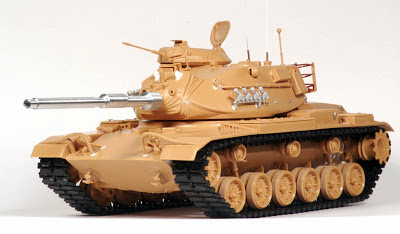Este es el primer post de una serie donde explico paso a paso el proceso de pintura del M60A3 TTS ET que se puede ver en este enlace: M60A3 TTS ET.
La primera etapa consta de tres pasos:
- Pintar el color base. Con el color acrílico de Tamiya XF-73 Dark Green (JGSDF) aclarado con XF-2 Flat White para conseguir el efecto escala. Los he mezclado en una proporción 80% verde y 20% blanco. Se diluyen con el disolvente específico para acrílicos de Tamiya X-20A al 50% y se aplican con aerógrafo en finas capas con una presión de aire de 1 Kg.
- Preempolvado de la base. A continuación he aplicado lo que yo llamo "preempolvado de la base". Para ello, mezclo un poco de XF-55 Deck Tan acrílico de Tamiya a la mezcla anterior un poco más diluído (60% disolvente y 40% pintura), y lo aplico con aerógrafo en las zonas más propensas a acumular polvo como ruedas o la parte superior de la torreta.Nota: Si te interesa conocer más a fondo este paso, permanece atento al blog, ya que en breve publicaré una entrada explicándolo.
- Marcas y detalles. Por último se pintan las marcas con aerógrafo y las partes de goma con acrílicos Vallejo a pincel.
¿Te ha parecido útil o interesante este post? Recuerda que tus comentarios siempre son bien recibidos.
This is the first post in a series where I explain step by step the painting process of the M60A3 TTS ET which can be viewed at this link: M60A3 TTS ET.
Stage one
This is the first post in a series where I explain step by step the painting process of the M60A3 TTS ET which can be viewed at this link: M60A3 TTS ET.
Stage one
The first stage consists of three steps:
- Paint the base color. With Tamiya acrylic color XF-73 Dark Green (JGSDF) highlighted with XF-2 Flat White for the scale effect. I've mixed it in a ratio 80% green and 20% white. Diluted with the specific Tamiya acrylic solvent X-20A in a ratio of 50% and applied with airbrush in thin layers with an air pressure of 1 Kg.
- Dusting the base color. Then I applied what I call "dusting the base color". To do this, I mix up some Deck Tan XF-55 Tamiya acrylic color to the previous mixture a little more dilute (60% thinner and 40% paint), and I apply it with an airbrush in the areas most prone to dust as wheels or top of the turret.Note: If you are interested in learning more about this step remains attentive to the blog since shortly I'll publish a post explaining it.
- Marks and details. Finally I've paint the marks with airbrush and the rubber parts with Vallejo acrylic color using a brush.
Do you find this post helpful or interesting? Remember, your comments are always welcome.













